There’s a relationship between sunning behavior in birds and parasite management.
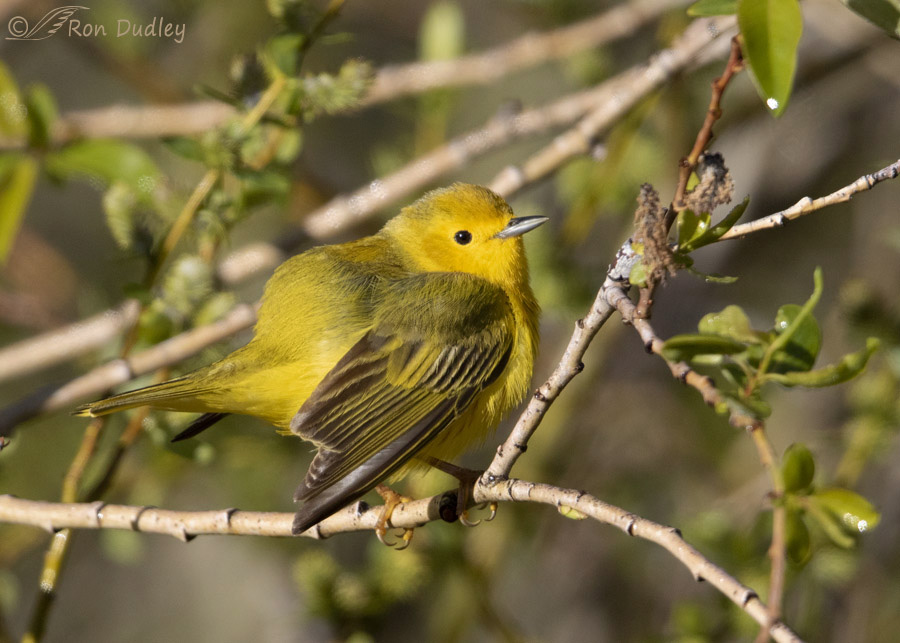
1/4000, f/5.6, ISO 800, Canon 7D Mark II, Canon EF 500mm f/4L IS II USM + EF 1.4 III Extender, not baited, set up or called in
Recently I posted this photo of a Yellow Warbler doing his best Quasimodo imitation in an effort to better expose his plumage to sunlight. The light and resulting heat from this behavior (referred to as sunning) encourages parasites, feather lice in particular, to move to more accessible areas so the bird can more adequately deal with them during preening.
The following photos document the preening behavior he was preparing for. Almost by definition (because of the contorted poses) I don’t have a catch light in the eye in some of them but since this series is documentary in nature I’m not too concerned about it.
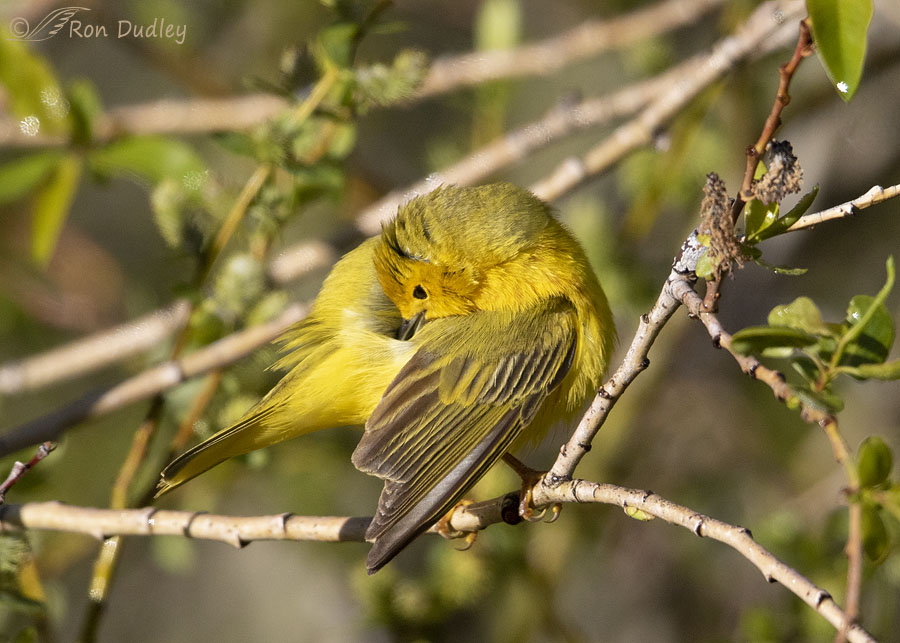
1/4000, f/5.6, ISO 800, Canon 7D Mark II, Canon EF 500mm f/4L IS II USM + EF 1.4 III Extender, not baited, set up or called in
After sunning for a few moments he began to dig for the presumed lice and at first he did so right at the base of the feathers he had raised on his back.
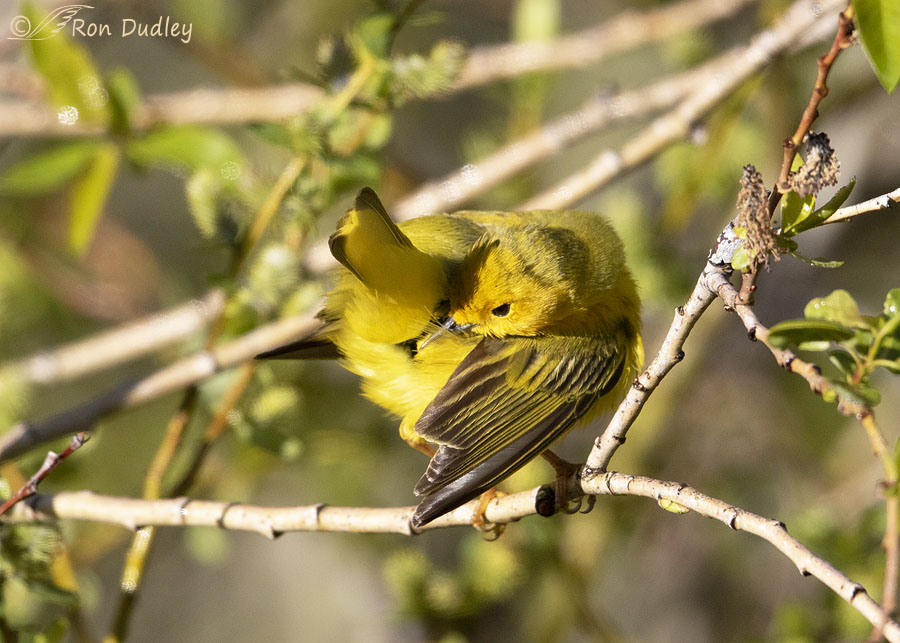
1/4000, f/5.6, ISO 800, Canon 7D Mark II, Canon EF 500mm f/4L IS II USM + EF 1.4 III Extender, not baited, set up or called in
Then he branched out to other nearby areas at the base of his tail – first the right side…
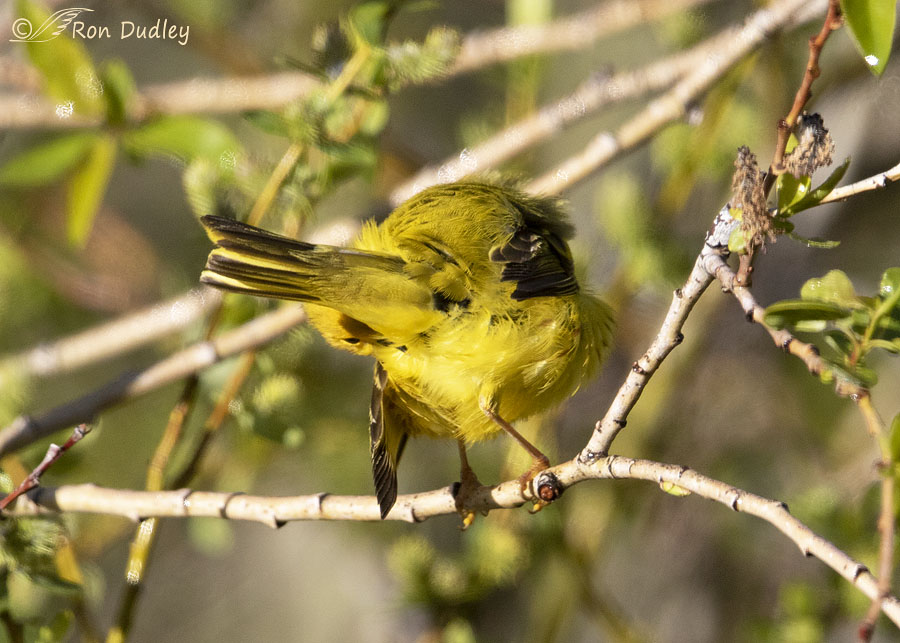
1/3200, f/5.6, ISO 800, Canon 7D Mark II, Canon EF 500mm f/4L IS II USM + EF 1.4 III Extender, not baited, set up or called in
and then the left. Some of these shots demonstrate one of several reasons birds have such flexible necks. Just imagine a fish trying to do this.
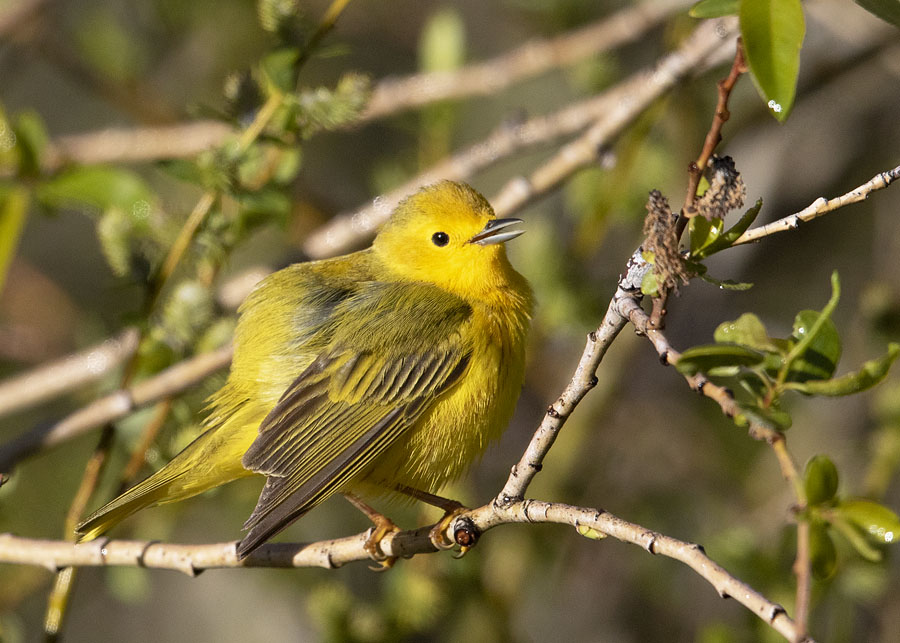
1/5000, f/5.6, ISO 800, Canon 7D Mark II, Canon EF 500mm f/4L IS II USM + EF 1.4 III Extender, not baited, set up or called in
At times he simply couldn’t resist taking a brief break in his preening routine for a musical singing interlude. After all, it is springtime and breeding season.
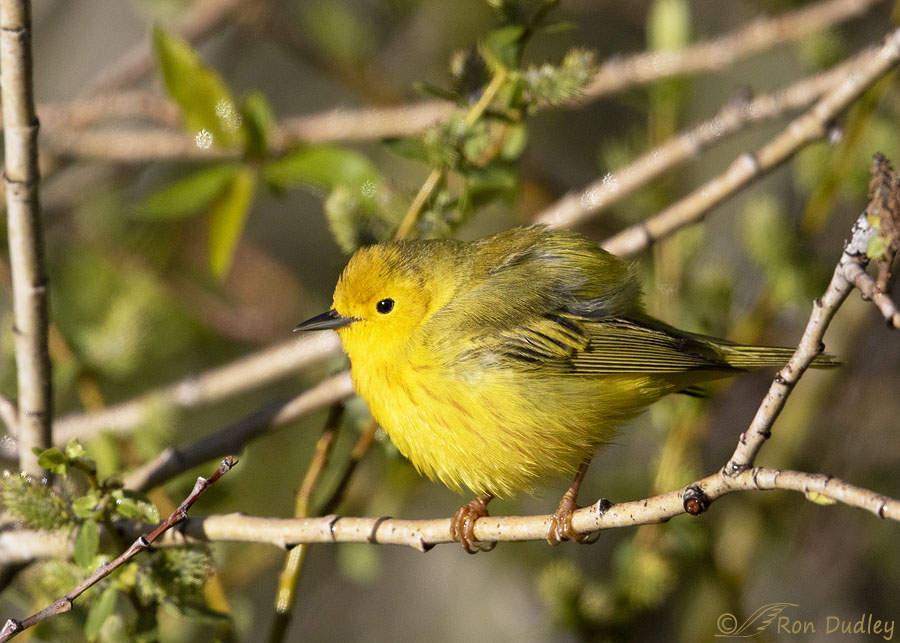
1/6400, f/5.6, ISO 800, Canon 7D Mark II, Canon EF 500mm f/4L IS II USM + EF 1.4 III Extender, not baited, set up or called in
After working over his right side he did a quick 180 to expose his left side to the sun. Most of the time he was turned further to his right than this to get even better sun exposure but in those shots I didn’t have a very good look at his eye.
But before he did much serious preening on his left side he flew off. And yes, I missed the takeoff shot. I had plenty of shutter speed for it but once again my reflexes weren’t up to the challenge.
I realize that most of my readers love birds and have watched them preening many times so these photos are nothing new. But I hope it was interesting to see them in the context of sunning and parasite management.
Ron


When I see a series of shots such as this, I can see what a contortionist he is!
Add the ability to fly and I most definitely would love to be a bird in my next life. A raptor for preference, but I will take anything I can get.
I’d mostly agree but I don’t think I’d want to be a vulture. My constitution is too…. delicate.
Yet another STUNNING series. I love to watch birds preen but don’t get to see the stills you gave us. I am also (being as supple as a brick) supremely envious of that flexiblility.
Thanks, EC.
Nice behavior series. I think they also sun for vitamin D and to help spread oil on their feathers from the uropygial gland. Sometimes if the light hits the birds beak just right I can see what looks like and oily edge and tip.
I am so ready for school to be out this year. I think I will spend my first 4 days in nature, rain or shine!
I remember the intensity of that feeling this time of year, April. I hope you go, either way – sun or not, but I hope you have good weather.
Ron, yet again some great shots and an educational piece from our teacher. I need to pay more attention to the birds in our back yard because some of them appear to sit on the feeder for quite a while, fluff up their feathers and “dig” in on the right and left side. I never knew they were trying to get at those parasites. Thank you for this post, Ron
Thanks, Alice. Birds preen for other reasons too but when you see them “digging” into their plumage they’re probably going after those pesky parasites.
An additional note about preen gland secretions: We often refer to preen gland secretions as oil (liquid fats), but it is actually much more complex. Secretions from this gland are rich in waxes, fatty acids, solid or semi-solid lipids (fats) and water. Just an oily liquid would matt the feathers and be detrimental to maintain water-proofing by allowing the barbs to slide apart and lose the tight structure needed to provide water-proofing. Think of birds in oil spills. Just oil would spread through the feather instead off adhering to it to provide needed protection and conditioning.
Wonderful shots and fascinating commentary! Dan, thanks for the additional info. I always thought that preen gland secretions played some role in waterproofing and, as always, am grateful to learn something new! 😀
Ron, I hope you are out in the field right now — chocolate donut in hand. 😉
Until several years ago I used to think the same thing about a major connection between preen oil and waterproofing, Marty. One of those things that makes sense but isn’t true.
Yup, I’ve been out shooting all morning but the donut has been gone for many hours now. At this point I’m thinking about lunch…
Birds have long necks, typically 14 vertebrae, whereas all mammals (with the exception of 4 species) from mice, men, girraffes,or whales have only 7. As you beautifully document, that long, flexible neck allows the bird to preen easily All areas can be reached except the head and neck which are preened by scratching with the feet. But, that flexible neck allows another action and that’s the collection of secretions from the preen gland at the base of the tail. The top of the head is used to collect these secretions and spread them through the feathers. In answer to Dick’s question, the secretions add very little to do any water-proofing of the feathers They help discourage some parasites, promote the growth of healthy bacteria, and discourage the growth of keratin-degrading bacteria and fungi. Of course these secretions help to keep the feather in good shape which is important in water-proofing. But most of the water-proofing has to do iwth the micro-structure of the feather itself. Watch as birds preen and run their beak along the length of each feather. This “re-zips” the feather and reattaches adjacent barbs. A feather in good shape then becomes water-proof because of the tightness of its barbs, not preen gland secretions
My high school students were often flabbergasted to learn that giraffes and humans have the same number of vertebrae.
I’ve described that “re-zipping” of the hooks several times in previous posts. I think it’s a pretty neat trick and the evolution of the structures necessary for it to be effective fascinates me.
Thanks for another excellent collection of fascinating facts about birds, Dan.
Warbler redux
While seeing how nicely this Warbler does preen,
It’s clear she’s no slouch in the ways of hygiene,
With flexible neck,
While sun disinfects,
A song seems just right for this scene.
An excellent summary of my entire post in only 5 lines, Lyle.
Excellent series Ron. When you watch birds they do spend lots of time pruning and often as you show here they enlist the aid of the sun to remove parasites. During my many years of observing our eagles I have often seen them facing the sun with wings spread wide to allow the sun to help clean up the parasites. Of course they will also do it for warming and drying, but more often I have seen them on warm dry summer days doing it as part of the grooming process. Those Warblers sure are pretty birds. Great series of photos.
Everett Sanborn, Prescott AZ
Thank you, Everett. Agree, Yellow Warblers are pretty spectacular. The fact that they’re common is only a bonus.
Great lesson in a method to their madness for grooming! 🙂 Was not aware of the sun getting parasites to move to a location more easily accessed by the bird! 🙂 They are definitely contortionists when it comes to preening…. S breeze so a little less smoke today.
Good news about the smoke, Judy. Now if the lessening only continues.
Most interesting. Watching the preening process and the contortions birds go to is very interesting. Until I began to simply sit and observe birds before photographing them, I never realized the extensive time they spend with this process. Water bathing, dust bathing, snow bathing…all so interesting and when you find out why each action is important, it all makes perfect sense. Last summer I watched a marsh wren stretch his wings out, lay them across reed, extend his head forward and close his eyes. Believe me when I say I thought he was dying! I had no clue but of course he didn’t and repeated the process several times again. Perfect poses of sunbathing!
I’d have enjoyed seeing that sunning wren, Kathy. An extreme sunning pose like the one you describe is something I’ve only rarely seen.
Excellent lesson, great images, beautiful behavior poses.
Question: Besides protecting the bird from water making the feathers and body waterproof, does the oil gland at the base of the tail help in protecting it from parasites/insect feather damage? I’ve thought it did, but not certain of that fact.
Thanks, Dick. Sorry for the late response but I left home very early to go shooting. For an authoritative answer to your question see Dan Gleason’s comment above.